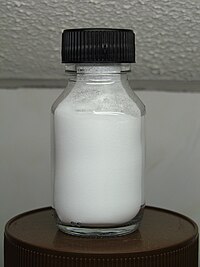Potassium benzoate
|
|
|||
 |
|||
| Names | |||
|---|---|---|---|
|
IUPAC name
Potassium benzoate
|
|||
| Identifiers | |||
|
582-25-2 |
|||
| 3D model (Jmol) | Interactive image | ||
| ChemSpider |
10921 |
||
| ECHA InfoCard | 100.008.621 | ||
| EC Number | 209-481-3 | ||
| E number | E212 (preservatives) | ||
| PubChem | 23661960 | ||
| UNII |
763YQN2K7K |
||
|
|||
|
|||
| Properties | |||
| C7H5KO2 | |||
| Molar mass | 160.21 g·mol−1 | ||
| Appearance | White hygroscopic solid | ||
| Odor | Odorless | ||
| Density | 1.5 g/cm3 | ||
| Melting point | >300 °C (572 °F; 573 K) | ||
| 69.87 g/100 mL (17.5 °C) 73.83 g/100 mL (25 °C) 79 g/100 mL (33.3 °C) 88.33 g/100 mL (50 °C) |
|||
| Solubility in other solvents | Soluble in ethanol Slightly soluble in methanol Insoluble in ether |
||
| Vapor pressure | 1.6 Pa | ||
| Hazards | |||
| S-phrases | S22-S24/25 | ||
| NFPA 704 | |||
| Flash point | 111.4 °C (232.5 °F; 384.5 K) | ||
| 950 °C (1,740 °F; 1,220 K) | |||
|
Except where otherwise noted, data are given for materials in their standard state (at 25 °C [77 °F], 100 kPa).
|
|||
|
|
|||
| Infobox references | |||
Potassium benzoate (E212), the potassium salt of benzoic acid, is a food preservative that inhibits the growth of mold, yeast and some bacteria. It works best in low-pH products, below 4.5, where it exists as benzoic acid.
Acidic foods and beverages such as fruit juice (citric acid), sparkling drinks (carbonic acid), soft drinks (phosphoric acid), and pickles (vinegar) may be preserved with potassium benzoate. It is approved for use in most countries including Canada, the U.S., and the EU, where it is designated by the E number E212.
Potassium benzoate is also used in the whistle in many fireworks.
One very common way to make potassium benzoate is by oxidizing toluene to benzoic acid followed by a neutralization with potassium hydroxide. Another way to synthesize potassium benzoate in the lab setting is by hydrolyzing methyl benzoate with potassium hydroxide.
The mechanism of food preservation begins with the absorption of benzoic acid into the cell. If the intracellular pH changes to 5 or lower, the anaerobic fermentation of glucose through phosphofructokinase is decreased by 95%.
...
Wikipedia



